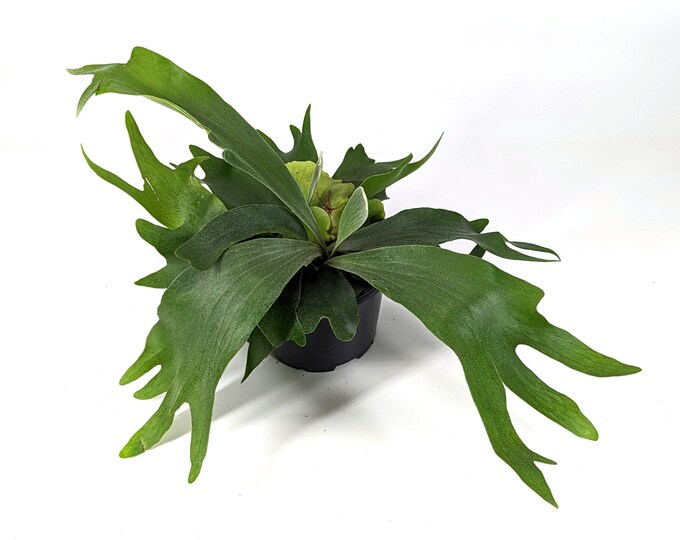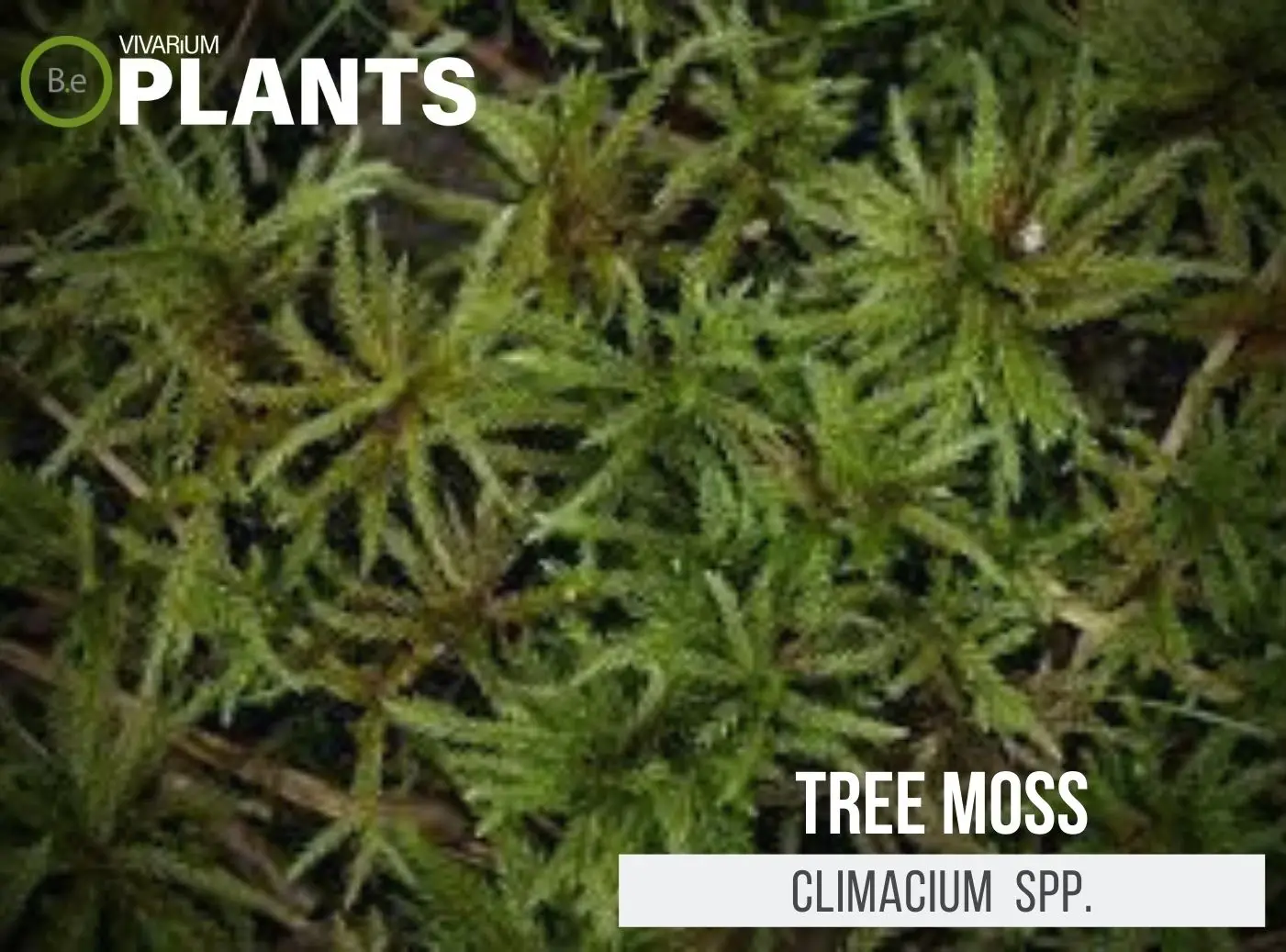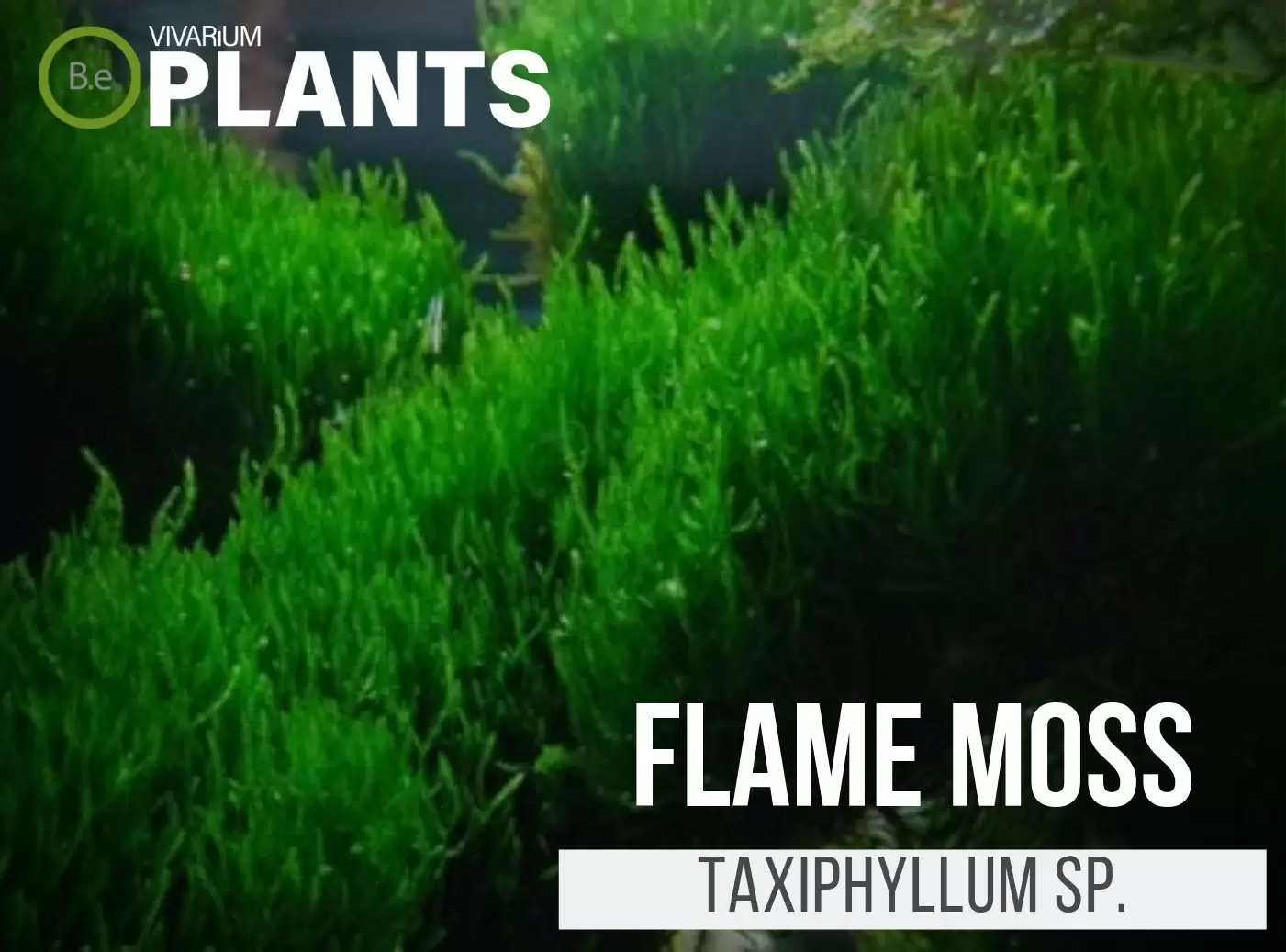Platycerium spp. (Staghorn ferns) is an epiphytic terrarium fern ideal for any enclosure with or without animals.
Staghorn ferns are easy to care for and are best known for their unique shape, resembling the horns of a stag.
Growing as a clump, Staghorn ferns tend to resemble a deep-sea creature such as a manta ray.
Because of their hearty nature, Staghorn ferns are a great low-maintenance vivarium plant.
| Quick Stats: | |
|---|---|
| Scientific Name | Platycerium spp. |
| Common Name | Staghorn Fern, Elkhorn Fern |
| Family Name | Polypodiaceae |
| Habitat | Sub-Tropical |
| Temperature | 70°F to 80°F |
| Height | 4 to 6 inches |
| pH | 6.0 to 7.0 |
| Lighting | Bright |
What Are Staghorn Ferns?
Platycerium spp., a.k.a staghorn ferns, are epiphytic ferns native to tropical regions of the Northern Hemisphere, from the southeastern United States to South America and Indonesia.
As a member of the Polypodiaceae family, Staghorn ferns are non-vines and form a rosette using a unique combination of fronds and traditional leaves.


Staghorn Ferns Facts
Staghorn ferns come in a variety of colors ranging from green to bronze.
They are a relatively low-maintenance plant and one of the most forgiving ferns a hobbyist can own.
As an epiphyte species, they grow off the side of trees, living off the moisture and nutrients provided by their surroundings.
Description
Staghorn ferns form as a clump or as a single-stalked fern.
The first leaves, or fronds, form a shield protecting the plant against strong winds and direct sunlight.
Its overlapping horn-like leaves grow in a circular shape, the outer fronds resembling a shield, five to six inches tall.
The center of the plant has a deep root system, providing moisture, food, and stability.
It’s ideal to have these ferns on a piece of wood, as they do not thrive in soil.
Habitat
Staghorn ferns are found in sub-tropical regions of the Northern Hemisphere.
In their native environment, these ferns will sprout off the side of trees, taking in the moisture and nutrients provided by their surroundings.
PH Preference
The ideal potential hydrogen value for Staghorn ferns to thrive is between 6.0 and 7.0.
They generally prefer wetter soil and need to be placed in a well-draining substrate.
Vivarium Type
This type of fern will do great in a variety of vivarium types.
When deciding if rather or not to use Staghorn Ferns in a particular type of enclosure, Be sure to go with setups that have dry terrain areas.
Here are recommended vivariums staghorn fern will do well in:
-
- Paludariums – Half aquatic/ half terrain-based enclosure.
-
- Ripariums – Mostly aquatic-based enclosures with some terrain features present.
-
- Terrariums – Fully terrain-based enclosures with little to no aquatic features.
Vivarium Placement
Staghorn ferns are non-vining epiphyte ferns and should not be put in the soil.
To best replicate their native environment, these plants should be mounted on pieces of wood, branches, or slabs of rock.
For a single-stalked fern, place the center on the substrate and spread its fronds out to form a shield.
Substrate
Staghorn ferns need a well-draining substrate and consistent support.
Because they will not be placed in soil, the substrate should be a bit firm and more of a solid base.
Rock, wood, and cork pieces are great homes for the Staghorn fern.
To help with stability, surround the base with some aquarium-safe sealant to keep the plant in place.
Lighting
Epiphytes, like the Staghorn fern, need either bright or moderate lighting.
It should never be placed in direct sunlight to avoid scorching or drying out.
For artificial light, LEDs, compact fluorescents, or other bright white or blue-white lights are ideal replication for the sun.
Buy Staghorn Ferns
When shopping for Staghorn Ferns, expect a few key indicators you are buying the best quality plant.
The fern should be slug free along with any other type of pest.
The source of the fern will usually be sold in a small potted cluster, ready for you to re-pot.
The batch should arrive fairly damp and in fairly good shape.
Click the image below to find out more about the current price and other relative info:


Staghorn Ferns Care and Propagation
Staghorn ferns are great for beginning hobbyists and easily propagated with spores or existing parts.
To propagate, simply remove a healthy, non-rotted piece from an existing fern and wait for it to form a new clump.
The new clump can then be mounted on a piece of driftwood and placed within the vivarium.
How to grow
Though practicing hands-off care is ideal, some maintenance helps Staghorn ferns thrive.
Cleaning the dead fronds off and repositioning the plant occasionally can help water absorption and promote continuous growth.
In the wild, Staghorn ferns are used to the environment’s changing temperatures, sunlight, moisture, and humidity, as a vivarium can mimic these conditions.
Watering
Drenching the fern with an aquarium-safe spray bottle once a week is sufficient watering.
The mist off the dead fronds to avoid rot and mold buildup.
Too much water can cause the fern to rot, so be sure to avoid direct water to the center of the plant.
Plants Similar to Staghorn Ferns
Adding diversity to an enclosure is key to an aesthetically pleasing enclosure.
Try mixing up the look of your vivarium with different flora that can easily co-exist in the same types of environment.
Furthermore, if for some reason you find this Fern hard to acquire or would like to consider something similar to this plant…
Here are some other plants you might find may do well with or in place of Platycerium spp:
Conclusion
I strongly recommend staghorn ferns for any vivarium.
Care of this fern is uncomplicated and it is great for fern lovers without much experience.
It can really make an enclosure look unique and lively with its distinctive, horn-like leaves.
Now that you know about this terrarium plant, it’s time to go out and start styling your own Staghorn fern vivarium.
Frequently Asked Questions
Staghorn Ferns (Platycerium spp.) are an interesting and unique type of evergreen ferns known for their unique frond shapes. These plants have two distinct types of fronds – antler–like “staghorns” and sterile, shield–shaped fronds that lay flat on the ground. The staghorns act as a nutrient catchment for the plant, allowing them to thrive in dry or low–nutrition conditions. They are also prized for their dramatic and distinctive appearance, making them a popular choice for home or office decor.
No, Staghorn Fern (Platycerium spp.) is fairly easy to care for. They require filtered or indirect light, soil that is well drained, and need to be periodically misted with water to ensure the area is humid enough for them to thrive. With the right care, your Staghorn Fern can remain healthy for many years.
Staghorn Ferns (Platycerium spp.) thrive best in indirect light with high humidity, temperatures between 70–80°F, and soilless potting media that is well drained. Prefers a warm, tropical climate, but can be grown indoors in the right conditions.
Yes, Staghorn Ferns (Platycerium spp.) can grow indoors in a location that offers bright but indirect light, high humidity, and temperatures between 70–80°F. Watering should be done weekly, and the soil should be treated with a fertilizer made for epiphytic plants.
Yes, Staghorn Ferns (Platycerium spp.) can multiply by producing new fronds or splitting the two clumps by division. A division is formed when two separate plants grow from the same root. The division can then be separated by cutting the root in half and replanting the resulting divisions. The most common way for a Staghorn Fern to multiply is to repot the plant and separate one clump from the other.
Yes, wiping the leaves of your staghorn fern is important to keep them healthy. Staghorn ferns should be gently wiped down on a regular basis to remove dust and pests from the leaves. Wiping the leaves will help prevent fungal diseases, which can lead to plant wilting and leaf yellowing. Additionally, moistened cotton wool is recommended for wiping down the leaves, as this will help keep the plant hydrated.
Staghorn ferns meaning they attach to trees and other things in the wild. An ideal way to grow them is by mounting them to a log, a tree, a board, rather than planting them in a pot, as this is the most natural way to cultivate them.
Staghorn ferns can live for up to 20 years with proper care. These long–lived greenery staples require low light, high humidity, moist soil, and a steady temperature between 70°F and 80°F.



